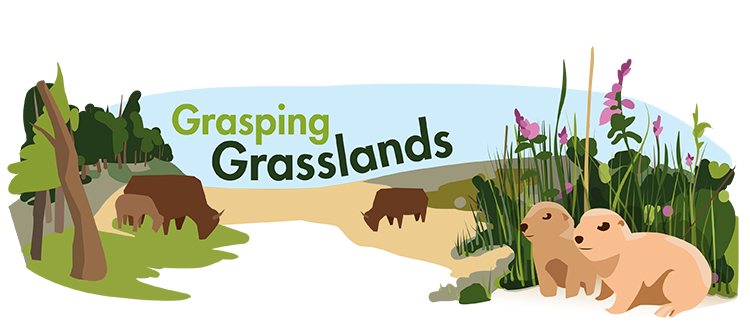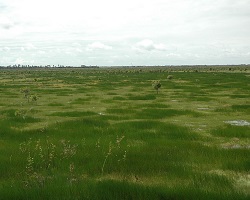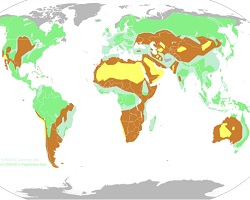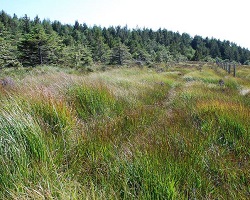
Illustrated by: James Baxter
Ruled by Grass

If you live in a city or a suburb, maybe you've never seen grass outside of a lawn at the local park or in your front yard. But you probably know that you have to work hard to keep a lawn nice. You have to water it and mow it. You have to pull up the weeds, dandelions, and tree seedlings that sprout. You'll need to fertilize it and add more seed if patches die out. You likely have only one type of grass.
At its simplest, a grassland is what it sounds like – land covered mostly in grass, just like a lawn. However, once you take a close look, you'll find that a carefully kept lawn and a wild grassland aren’t much like each other at all.
A grassland doesn't have a human gardener to tend it, weed it and keep it full of healthy grass. This means that the environment itself has to keep trees from overgrowing the grassland and that the grass has to have adaptations to stay healthy. Grasslands are also home to many different kinds of grass as well as other plants, like flowers, shrubs and even a few trees. It is home to animals that live both above and below ground and come in all different sizes, from as small as a prairie dog to as large as a bison.
Many Names, Many Kinds
Grasslands have many names around the world. North American grasslands, home to famous animals like the American bison and the prairie chicken, are called prairies or plains. They are also called either tall-grass or short-grass prairies depending on the type of grass that grows there.

South African grasslands are known as velds, while South America has pampas and llanos. In Europe and Asia, grasslands are called steppes, although in Hungary, they call them puszta. Grasslands that occur in the middle of forests are often called meadows.
Why do we bother using so many names? Aren't grasslands the same everywhere? In fact, they're not. Depending on where they are, grasslands can be very different. They get different amounts of rainfall. Some are so dry they're called desert grasslands, while others are flooded all or part of the year. Many are flat, but some occur on mountainsides.
They also have very different species of plants and animals. Some grasslands in Nepal have grass species that reach up to 6 meters tall – almost twenty feet – while some United States grasslands have grasses less than a foot tall. You won't find a rhinoceros and a black-footed ferret in the same place, even though they're both grassland animals. Rhinoceroses live in velds, while black-footed ferrets are prairie animals.
The Geography of Grasslands

The grassland biome is widespread around the world, and it's found at a wider range of latitudes (our north-to-south measure of the earth) than many other biomes, such as rainforests, deserts or tundra.
Grasslands are found on every continent, except Antarctica. They aren't found in the arctic either, where the climate is simply too extreme for grasses to thrive.
Depending on where grasslands are found, they can be either tropical, which means they stay about the same temperature year round, or temperate, which means they have hot summers and cold winters.
A Transitional Biome?

If you look at a continent where both the forest and desert biomes are found, you'll often find that grasslands lie in between them. Not only that, but some of those deserts and forests were once, long ago, grasslands. Areas where trees started to sprout on the grassland became forest. Areas where grass died out became desert.
For this reason, the grassland biome is considered a transitional biome, halfway between the forest and desert biomes. A grassland can become either a desert or a forest if conditions like temperature, amount of rainfall, how often fires occur and how many herbivores live in these areas change. As more and more trees grow in a grassland, it is sometimes called a savanna.
Images via Wikimedia commons. Subtropical grassland image via Katy Prairie Conservancy.
Read more about: Grasping Grasslands
Bibliographic details:
- Article: Grasping Grasslands
- Author(s): Stephanie Bittner
- Publisher: Arizona State University School of Life Sciences Ask A Biologist
- Site name: ASU - Ask A Biologist
- Date published:
- Date accessed:
- Link: https://askabiologist.asu.edu/explore/grassland
APA Style
Stephanie Bittner. (). Grasping Grasslands. ASU - Ask A Biologist. Retrieved from https://askabiologist.asu.edu/explore/grassland
Chicago Manual of Style
Stephanie Bittner. "Grasping Grasslands". ASU - Ask A Biologist. . https://askabiologist.asu.edu/explore/grassland
Stephanie Bittner. "Grasping Grasslands". ASU - Ask A Biologist. . ASU - Ask A Biologist, Web. https://askabiologist.asu.edu/explore/grassland
MLA 2017 Style

This colorful subtropical grassland in southeastern Texas shows the wide variety of plants that can live in a grassland.
![]() Try our Virtual Biomes
Try our Virtual Biomes
Be Part of
Ask A Biologist
By volunteering, or simply sending us feedback on the site. Scientists, teachers, writers, illustrators, and translators are all important to the program. If you are interested in helping with the website we have a Volunteers page to get the process started.

